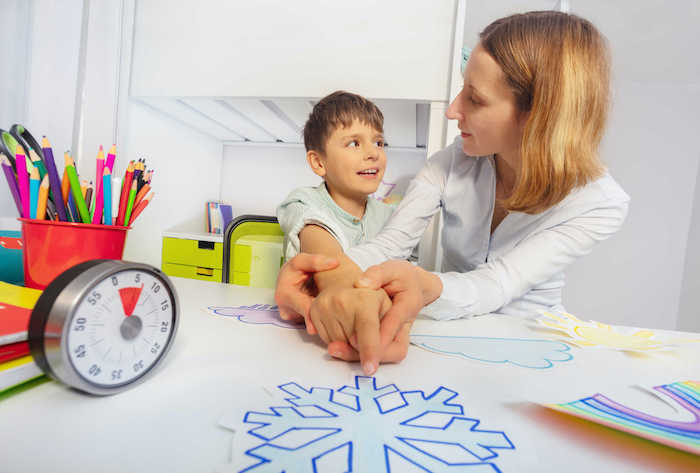Working Memory and Autism
Is there a relationship between working memory and autism? Children with autism may appear inattentive or disinterested in their surroundings. However, research has shown that their brain structure differs from that of their peers. Specifically, the prefrontal cortex (the region responsible for working memory) is significantly impacted in children with autism with increased gray matter volume. This connection between an abnormal prefrontal cortex and autism suggests a potential link between working memory and behavior. In a school setting, working memory plays a crucial role in learning. Therefore, it is possible that the difficulties children with autism face in learning and adapting may be related. Understanding how children with autism learn and develop is an essential step in addressing their unique needs.
This article will cover
- What is working memory?
- Some challenges for a child with autism and working memory
- Learning Strengths of Children with Autism
- Visual Aids strengthen Procedural Memory
- How ABA programs help with learning rates

What is working memory?
Short-term memory, or working memory, helps us with executive functioning; this includes decision-making, task control, reasoning, and behavior regulation. It is necessary for processing information and managing multiple tasks simultaneously. This memory type helps children briefly remember information and use it to complete tasks. Working memory allows them to recall details from their environment, such as instructions, conversations, and visual imagery. It is vital for problem-solving skills and understanding cause-and-effect relationships.
For example, reading is a complex skill that requires coordinating various tasks, such as higher and lower-order reasoning. It involves decoding, activating word meanings, understanding arrangement, referencing prior knowledge, guessing unknown words, processing overall meaning, situating in context, and retaining comprehension. Children with autism face challenges in comprehension.
For children with autism, working memory deficits can both be a cause and a consequence of their difficulties. Working memory helps children process language, understand instructions, and plan task completion steps. Without the ability to access prior information or maintain focus on current tasks, children with autism may have difficulty following directions, comprehending conversations, or recalling essential facts.
Some challenges for a child with autism and working memory
Autism refers to a group of complex neurodevelopmental disorders that impact memory, communication, and behavior in different ways. As with any cognitive function, autism can present strengths and challenges in memory. It is crucial to understand that autism is a spectrum, and memory abilities and challenges can vary greatly among individuals.
One notable challenge is the difficulty in generalizing information, where individuals may struggle to apply knowledge learned in one context to different situations. The struggle is real when it comes to generalizing information. It’s like trying to fit a square peg into a round hole – sometimes, what we learn in one context doesn’t seem to apply in other situations. It’s like trying to teach a fish to ride a bicycle!
One hurdle that children with autism face is the art of seamlessly transitioning between tasks or activities. Their minds become stuck in a specific gear, making switching gears or adapting to new routines more challenging.
In addition, one might find themselves stumbling through social cues and struggling to decipher the hidden messages and unspoken signals accompanying human interaction.
Furthermore, children with autism may find it challenging to understand abstract concepts, as they tend to prefer concrete and tangible information.
The intricate workings of a child’s memory, particularly those with Autism Spectrum Disorder, are like a captivating puzzle waiting to be solved. Regarding working memory profiles, it’s fascinating to discover that high-functioning children might surprise us with their above-average verbal memory skills while low-functioning children might face challenges similar to those with specific language impairments. Let’s not forget, in the grand scheme of things, low-functioning ASD children often find themselves with a working memory that pales in comparison to their typically developing peers.
Learning Strengths of Children with Autism
The visual-spatial working memory profile does not show any deficits, which is why individuals with this profile perform well with visual cues such as pictures, visual activity completion boards, visual schedules, etc. Using visuals for children with autism can help reduce stress and anxiety that may arise during transitions between events throughout the day.
Visual-spatial working memory is an area of strength for those with autism. This type of memory refers to the ability to remember and recall visual images, spatial relationships, spatial orientation, and information contained in diagrams. It also includes the ability to manipulate objects in a three-dimensional space. Individuals with this type of working memory profile may recognize patterns easily and work out problems visually rather than verbally.
Another strength that individuals with autism possess is a strong capacity for attention to detail and the ability to focus on specific tasks and activities without becoming easily distracted. This can help children with autism stay focused when presented with difficult or tedious tasks that require concentrated effort and attention to detail. In addition, children with autism may be able to remember information more accurately than their peers due to their strong capacity for detail-oriented tasks.
Learning the strengths of a child with autism can help parents, teachers, and other caregivers better understand how to support them. By understanding their individual strengths, educators can create an environment that encourages learning by playing to those strengths. For instance, a child may be mainly engaged when presented with visual material or in music and art activities.

Visual Aids strengthen Procedural Memory
Procedural memory is a type of long-term memory that enables recalling tasks without conscious thought, such as walking, riding a bike, or driving a car.
When it comes to tasks, the more the child can describe the sequence, the more natural the task becomes, as it becomes part of their implicit/unconscious memory. In terms of events, the more the child can describe and demonstrate them, the easier it is for them to pay attention to details. This process strengthens their declarative memory, which is more explicit/conscious.
Repetition is an effective method for transferring information from short-term memory to long-term memory.
5 techniques ABA programs might use based on where the child is on the spectrum:
- Forming habits through incremental learning and repetition
- Using visual cues
- Memory Games
- Sudoku
- Match the cards
- What’s missing?
- I went shopping…
- Creating stories – Children on the spectrum can learn and remember lessons if they are told in the form of a story.
- Documenting events with pictures – Episodic memory helps remember past experiences from one’s life. Revisiting these pictures and rereading their descriptions helps them reconnect the memories and boost overall recall.
Discover the perfect learning strategies that will unlock your child’s potential! Adapt, practice, and adjust to their unique needs. And remember, if you ever feel stuck, seek professional help to ensure their success!
How ABA programs help with learning rates
ABA program is designed to teach concepts by breaking them down into simple teachable steps in a distraction-free environment, such as in their bedroom or a quiet room in the house.
For example, it may be too difficult for a child with autism to learn to count from 1-10 at once. Therefore, each number in the sequence will be taught one by one, at the pace of your child’s learning (chaining). On Monday, they may learn the number ‘one,’ on Tuesday, if they still maintain the memory of the number “one,’ they will be taught the number ‘two,’ on Wednesday if they still retain the memory of numbers ‘one’ and ‘two,’ they will be taught ‘three,’ and so on. While this may seem like a prolonged learning rate, a child will be introduced at the rate they can learn.
With a deficit in working memory, it is essential to note that clear, concise, and simple instructions are typically more effective in producing effective learning opportunities. This is why simple and straightforward language is often used in ABA programs.
For example, the instruction, “point to number 1” is a much more straightforward instruction than “can you please point to the piece of paper that has the number 1 written on it?” and, therefore, is more likely to produce the desired response.
However, it is also important to note that with continued success, as attention and learning rates increase, language and instructions should be modified to include more complexity. This will help to promote generalization.
Children with autism typically need to not only learn in small steps but also require much repetition until the skill comes easily to them.
Therefore, in an ABA program, the learning environment is structured to allow as much repetition as a child needs while maintaining their motivation and interest in learning. When children begin ABA programs, they may need many repeats of the concept before learning or mastering it. However, it is expected to find that over time, as a child learns “how to learn,” these repetitions become fewer and fewer, and learning rates increase. Some describe these phenomena as “learning to learn.”
LeafWing can partner with you to help your child reach their full potential. Leafwing focuses on building a solid relationship between the learner and the therapy team, especially at the start of the ABA therapy program. The staff works on developing a positive connection with your child, which is essential throughout the program. In the first few weeks, play and conversation will make your child feel comfortable and enjoy their time with the Behavior technician. This creates positive experiences and enhances learning for better results.
Related Glossary Terms
Other Related Articles
- How To Use Visuals To Help Students With Autism
- Choice Boards And “Wait” Support For Students With Autism In The Classroom
- Using Time Warnings To Help Students With Autism
- Strategies For Autism In The Classroom
- Transition Strategies For Autistic Students
Frequently asked questions about ABA therapy
What is ABA Therapy used for?
ABA-based therapy can be used in a multitude of areas. Currently, these interventions are used primarily with individuals living with ASD; however, their applications can be used with individuals living with pervasive developmental disorders as well as other disorders. For ASD, it can be used in effectively teaching specific skills that may not be in a child’s repertoire of skills to help him/her function better in their environment whether that be at home, school, or out in the community. In conjunction with skill acquisition programs, ABA-based interventions can also be used in addressing behavioral excesses (e.g., tantrum behaviors, aggressive behaviors, self-injurious behaviors). Lastly, it can also be utilized in parent/caregiver training.
In skill acquisition programs, a child’s repertoire of skills is assessed in the beginning phase of the services in key adaptive areas such as communication/language, self-help, social skills, and motor skills as well. Once skills to be taught are identified, a goal for each skill is developed and then addressed/taught by using ABA-based techniques to teach those important skills. Ultimately, an ABA-based therapy will facilitate a degree of maintenance (i.e., the child can still perform the learned behaviors in the absence of training/intervention over time) and generalization (i.e., the learned behaviors are observed to occur in situations different from the instructional setting). These two concepts are very important in any ABA-based intervention.
In behavior management, the challenging behaviors are assessed for their function in the beginning phase of the services. In this phase, the “why does this behavior happen in the first place?” is determined. Once known, an ABA-based therapy will be developed to not just decrease the occurrence of the behavior being addressed, but also teach the child a functionally-equivalent behavior that is socially-appropriate. For example, if a child resorts to tantrum behaviors when she is told she cannot have a specific item, she may be taught to accept an alternative or find an alternative for herself. Of course, we can only do this up to a certain point—the offering of alternatives. There comes a point when a ‘no’ means ‘no’ so the tantrum behavior will be left to run its course (i.e., to continue until it ceases). This is never easy and will take some time for parents/caregivers to get used to, but research has shown that over time and consistent application of an ABA-based behavior management program, the challenging behavior will get better.
In parent training, individuals that provide care for a child may receive customized “curriculum” that best fit their situation. A typical area covered in parent training is teaching responsible adults pertinent ABA-based concepts to help adults understand the rationale behind interventions that are being used in their child’s ABA-based services. Another area covered in parent training is teaching adults specific skill acquisition programs and/or behavior management programs that they will implement during family time. Other areas covered in parent training may be data collection, how to facilitate maintenance, how to facilitate generalization of learned skills to name a few.
There is no “one format” that will fit all children and their families’ needs. The ABA professionals you’re currently working with, with your participation, will develop an ABA-based treatment package that will best fit your child’s and your family’s needs. For more information regarding this topic, we encourage you to speak with your BCBA or reach out to us at info@leafwingcenter.org.
Who Can Benefit From ABA Therapy?
There is a common misconception that the principles of ABA are specific to Autism. This is not the case. The principles and methods of ABA are scientifically backed and can be applied to any individual. With that said, the U.S. Surgeon General and the American Psychological Association consider ABA to be an evidence based practice. Forty years of extensive literature have documented ABA therapy as an effective and successful practice to reduce problem behavior and increase skills for individuals with intellectual disabilities and Autism Spectrum Disorders (ASD). Children, teenagers, and adults with ASD can benefit from ABA therapy. Especially when started early, ABA therapy can benefit individuals by targeting challenging behaviors, attention skills, play skills, communication, motor, social, and other skills. Individuals with other developmental challenges such as ADHD or intellectual disability can benefit from ABA therapy as well. While early intervention has been demonstrated to lead to more significant treatment outcomes, there is no specific age at which ABA therapy ceases to be helpful.
Additionally, parents and caregivers of individuals living with ASD can also benefit from the principles of ABA. Depending on the needs of your loved one, the use of specified ABA techniques in addition to 1:1 services, may help produce more desirable treatment outcomes. The term “caregiver training” is common in ABA services and refers to the individualized instruction that a BCBA or ABA Supervisor provides to parents and caregivers. This typically involves a combination of individualized ABA techniques and methods parents and caregivers can use outside of 1:1 sessions to facilitate ongoing progress in specified areas.
ABA therapy can help people living with ASD, intellectual disability, and other developmental challenges achieve their goals and live higher quality lives.
What does ABA Therapy look like?
Agencies that provide ABA-based services in the home-setting are more likely to implement ABA services similarly than doing the same exact protocols or procedures. Regardless, an ABA agency under the guidance of a Board-Certified Behavior Analyst follows the same research-based theories to guide treatment that all other acceptable ABA agencies use.
ABA-based services start with a functional behavior assessment (FBA). In a nutshell, a FBA assesses why the behaviors may be happening in the first place. From there, the FBA will also determine the best way to address the difficulties using tactics that have been proven effective over time with a focus on behavioral replacement versus simple elimination of a problem behavior. The FBA will also have recommendations for other relevant skills/behaviors to be taught and parent skills that can be taught in a parent training format to name a few. From there, the intensity of the ABA-based services is determined, again, based on the clinical needs of your child. The completed FBA is then submitted to the funding source for approval.
One-on-one sessions between a behavior technician and your child will start once services are approved. The duration per session and the frequency of these sessions per week/month will all depend on how many hours your child’s ABA services have been approved for—usually, this will be the number recommended in the FBA. The sessions are used to teach identified skills/behaviors via effective teaching procedures. Another aspect of ABA-based services in the home-setting is parent training. Parent training can take many forms depending on what goals have been established during the FBA process. The number of hours dedicated for parent training is also variable and solely depends on the clinical need for it. If a 1:1 session is between a behavior technician and your child, a parent training session or appointment is between you and the case supervisor and with and without your child present, depending on the parent goal(s) identified. Parent training service’s goal is for you to be able to have ample skills/knowledge in order for you to become more effective in addressing behavioral difficulties as they occur outside of scheduled ABA sessions. Depending on the goals established, you may be required to participate in your child’s 1:1 sessions. These participations are a good way for you to practice what you have learned from the case supervisor while at the same time, having the behavior technician available to you to give you feedback as you practice on those new skills.
As mentioned in the beginning, no two ABA agencies will do the same exact thing when it comes to providing ABA services; however, good agencies will always base their practice on the same empirically-proven procedures.
How do I start ABA Therapy?
In most cases, the first item required to start ABA therapy is the individual’s autism spectrum disorder (ASD) diagnosis report. This is typically conducted by a doctor such as a psychiatrist, psychologist, or a developmental pediatrician. Most ABA therapy agencies and insurance companies will ask for a copy of this diagnosis report during the intake process as it is required to request an ABA assessment authorization from the individual’s medical insurance provider.
The second item required to start ABA therapy is a funding source. In the United States, and in cases where Medi-Cal or Medicare insurances are involved, there is a legal requirement for ABA services to be covered when there is a medical necessity (ASD diagnosis). Medi-Cal and Medicare cover all medically necessary behavioral health treatment services for beneficiaries. This typically includes children diagnosed with ASD. Since Applied Behavior Analysis is an evidence based and effective treatment for individuals with ASD, it is considered a covered treatment when medically necessary. In many cases, private insurance will also cover ABA services when medically necessary, however in these cases, it is best to speak directly with your medical insurance provider to determine the specifics of the coverage and to ensure that ABA is in fact, a covered benefit. Additionally, some families opt to pay for ABA services out-of-pocket.
The next step to starting ABA therapy is to contact an ABA provider whom you are interested in working with. Depending on your geographic location, ABA agencies exist in many cities across the United States. Your insurance carrier, local support groups, and even a thorough online search can help you find reputable and properly credentialed ABA agencies near you. Our organization, LeafWing Center, is based in southern California and is recognized for aiding people with ASD achieve their goals with the research based on applied behavior analysis.
Once you have identified the ABA provider with whom you wish to work, they should help you facilitate the next steps. These will include facilitating paperwork and authorizations with your funding source. Once the assessment process begins, a BCBA (Board Certified Behavior Analyst) or qualified Program Supervisor should get in contact with you to arrange times in which interviews with parents/caregivers and observations of your loved one can be conducted. This will help in the process of gathering important clinical information so that with your collaboration, the most effective treatment plans and goals can be established for your loved one. This process is referred to as the Functional Behavior Assessment (FBA) and is elaborated on in different blog posts on our website. With regard as to what can be expected once ABA therapy begins, please read our blog post titled: When You Start an ABA program, What Should You Reasonably Expect from Your Service Provider?


























